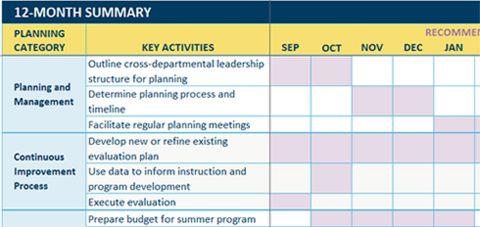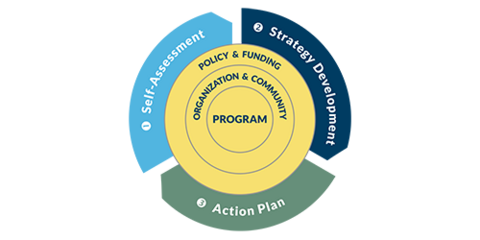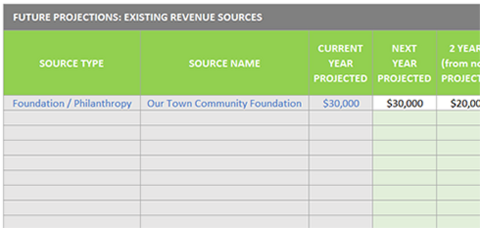Breadcrumb
- Wallace
- Toolkits
- Summer Learning Toolkit
Summer Learning Toolkit

Planning & Management
Launching a summer program is like starting a new school year, but with less time for planning and execution. A good planning process may be the most important characteristic of a strong program: It starts early, includes the right people and follows best practices in budgeting and continuous improvement.
Research shows that program leaders who commit to a program in the fall and begin planning by January run smoother programs with fewer disruptions. A timely planning process enables teachers to be hired earlier, contracts to be approved sooner and the curriculum to be ready for teacher training and planning. Such a process also enables more cross-departmental and partner staff to play meaningful roles in the program and results in better prepared staff and site leaders.


The Toolkit will help our district and schools build buy-in for early and well-coordinated planning to ensure that we're increasing our efficiency and quality from year to year.
— Brisa Huerta-Price, Expanded Learning Coordinator, Calexico Unified School District, Calexico, California
Example Milestones for Planning & Management

Getting it all done
The Summer Planning Calendar and Companion Tool takes the guesswork out of planning by organizing a comprehensive to-do list by month and topic. Based on the planning approaches of the five National Summer Learning Project (NSLP) cities and recommendations from RAND, the calendar includes both essential and recommended tasks as well as tips for successful implementation.
- Take a quick tour: Review each planning category in the calendar side by side with the corresponding guidance found in the Summer Planning Calendar Companion Guide.
- Make it your own: Set the timeline to match your program schedule. Begin by setting deadlines for major milestones.
- Identify a planning lead: Look for a leader with influence, authority and committed time for summer.
Summer Planning Calendar Resources
A comprehensive to-do list by month and topic paired with expert guidance.
Engaging the Right Team
Planning and sustaining a successful summer program involves more than an early start; it requires inclusive practices that attract support from both inside and outside of the district for year-round planning and long-term success.
- Build a year-round planning team: Invite the right district experts to your team. They may include curriculum, transportation, human resources, procurement, information technology and facilities leaders.
- Align your focus: Connect program goals to larger district goals for broader buy-in and sustainability.
- Cultivate champions: Use the Sustainability Planning Tools with key stakeholders to generate ideas for long-term district and community engagement.
Related Resources
Tools - Sustainability Planning
Tools for engaging stakeholders in strategic sustainability planning and action
Setting a budget
Thoughtful budgeting ensures you are spending precious funds on the most important elements of your program. The Summer Budget Tool was developed specifically for large summer programs run by districts and their partners and includes prompts for the most common revenue and expense categories.
- Find cost efficiencies: Determine where you can share costs within your program and across other district summer programs. Consider consolidating sites for savings on facilities and transportation.
- Use your data: Review last summer’s enrollment, attrition and attendance data to better estimate the number of staff you need this summer—your largest expense.
Related Resources
Related Resources
Tool - Summer Budget
Adaptable tool pre-populated with common revenue and expense line items
Engage in continuous improvement
While your outcomes data can tell you how well you did, continuous improvement data can tell you why, illuminating program strengths and growth opportunities across planning, implementation and operations. Classroom and activity observations and an end-of-program reflection with key stakeholders are two ways to fuel your improvement efforts.
- Be transparent: Let all staff and stakeholders know how program quality will be measured before the program begins.
- Focus your efforts: RAND found that no-show rates and attendance; loss of instructional time; instructional practice in academics and enrichment; and site climate were the most beneficial information for improving the program.
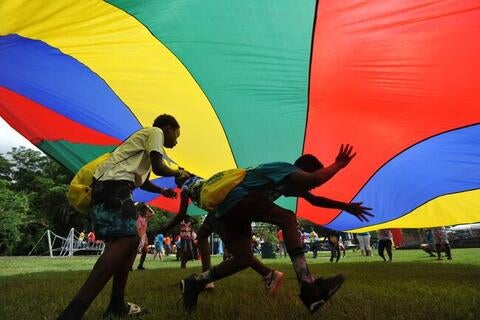
Related Resources
Tool - Summer Program Reflection Tool
Prompts to reflect on a recently completed program and begin planning for next summer
Tool - Classroom Observation
Indicators to assess learning environment, student engagement and instructional quality
Sample - Dallas Academic Lesson Observation Form
Includes measures of time on task, teacher engagement, transitions and use of technology
Samples - Pittsburgh Enrichment Activity Observation
Includes tools for assessing the quality of activities and providing feedback
ADDITIONAL PLANNING AND MANAGEMENT RESOURCES
The Toolkit includes an example site schedule, a sample data report for participating sites, and the process to approve district funding requests for summer learning programs.
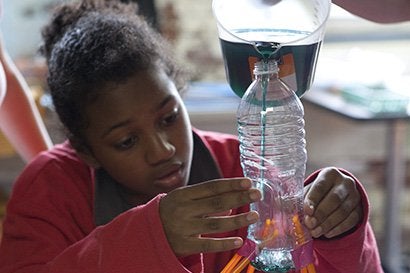
See the Related Resources
Sample - Boston YMCA Site Schedule
Snapshot of a typical program day and week, including group rotations
Sample - Boston Summer Program Data Dashboard
Report that shares demographics and measures of program quality for each site
Samples - Rochester Summer Program Approval Process
Materials used by district leaders to request, approve and launch summer programs
GET THE LATEST UPDATES

